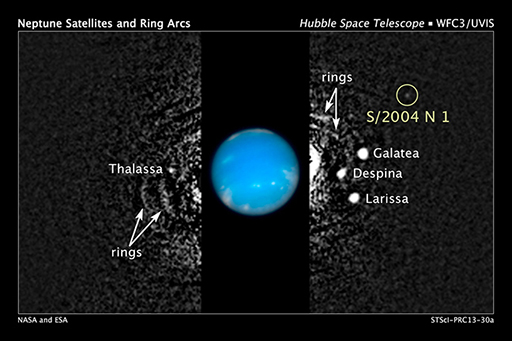1 Finding new moons
This week is all about exploration. How do we know about all these moons that you’ve been looking at? Well, apart from our own rather obvious Moon, it all began with telescopes of course. You may remember about Galileo discovering the four large moons of Jupiter in 1610. By 1700 five satellites of Saturn were known. Within six years of his discovery of Uranus in 1781, Sir William Herschel had found two of its moons. Triton, the largest moon of Neptune, was discovered less than three weeks after the planet itself was first seen in 1846. As time went by, smaller and fainter moons were discovered, either by peering or by taking long-exposure photographs through telescopes. Phobos and Deimos, the two small moons of Mars, were discovered visually using a 66 cm telescope in 1877. By 1950 the tally of outer-planet satellites was: Jupiter eleven; Saturn nine; Uranus five; and Neptune two.

Discoveries continue to be made using telescopes, such as the fourteenth known moon of Neptune (S/2004 N 1), only 20 km across, announced in July 2013 while this course was being prepared and shown in the figure above. It was first noticed in July 2013 on Hubble Space Telescope images made in 2009, but subsequently found on Hubble Space Telescope images dating back to 2004, hence the 2004 designation in its provisional name. In 2019, the International Astronomical Union gave it the official name Hippocamp. (In December 2023, the tally of confirmed moons of the outer planets stood at Jupiter 95, Saturn 145, Uranus 27, Neptune 14.)
However, many first sightings have also been made by visiting spacecraft, and without the close-up detailed images that these probes have beamed back to us, we would not have much to excite you – unless you really like orbits! That’s not quite fair, because by analysing the sunlight reflected from the moons that are large enough to give a clear signal (a technique called spectroscopy) you can tell what the surface is made of. Between the 1950s and 1970s it became clear that many moons at Jupiter and beyond have surfaces dominated by water-ice. Exceptions include Titan, whose spectrum is dominated by methane (which we now know to be in its atmosphere), and Io, where there is no ice but plenty of sulfur. But knowing their surface composition is not nearly enough to tell us what they are really like.
This week, you will discover what spacecraft can tell us about moons a long way from home. The week begins with the history of outer Solar System exploration, which basically means the four great projects so far: the two Voyagers, Galileo and Cassini–Huygens.
